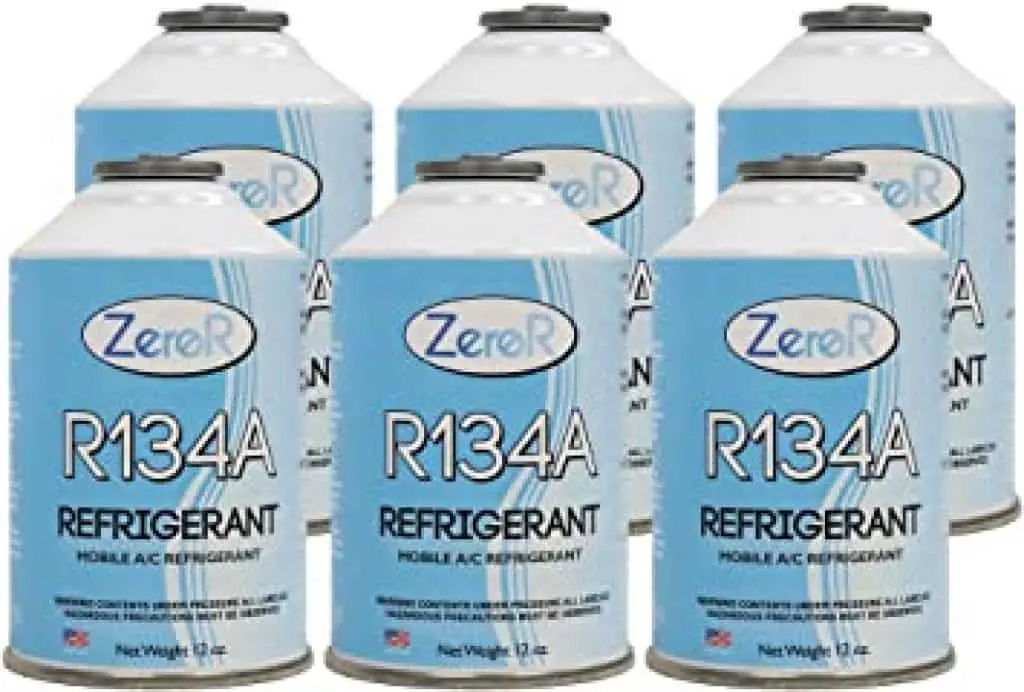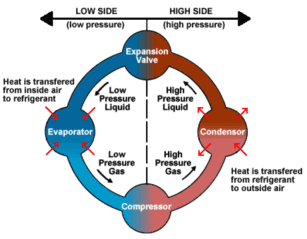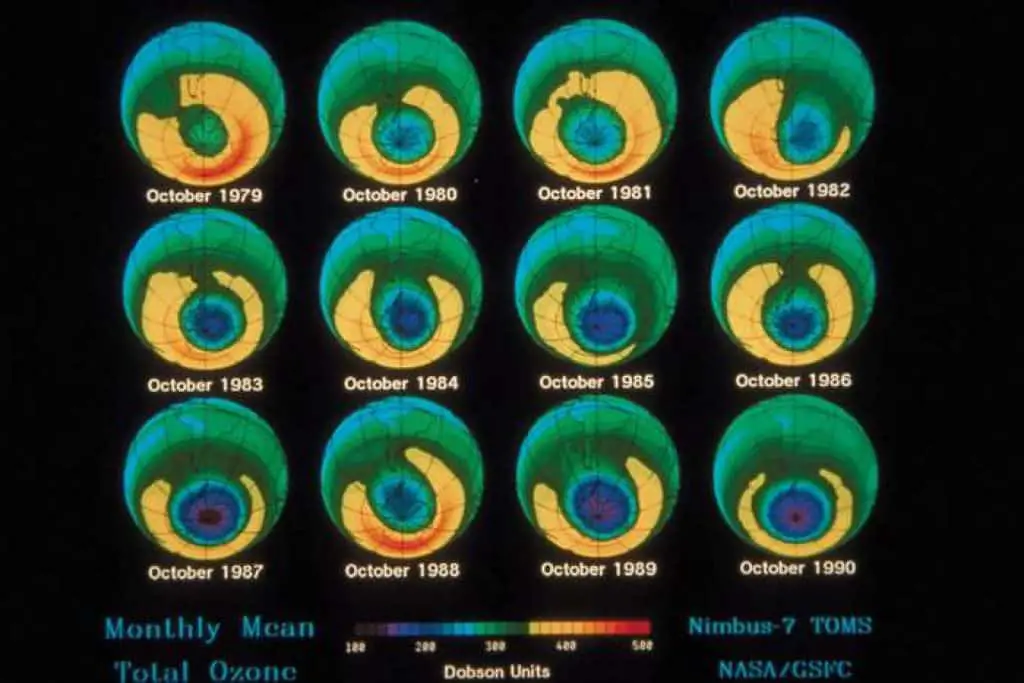Every year during our AC servicing or refrigerator servicing, we change the gas. Right? What is that gas? What does that gas do?
That gas is called refrigerant, and it is responsible for the cooling effect that an AC or Refrigerator offers.
In this article, You will find information about what are refrigerants and what are the different Types Of refrigerants.
Here we have also provided you a comparison of different refrigerants like R32 vs R410A vs R22 vs R290 and R32 vs R410, R410A vs R32, R22 Vs R290A, R32 refrigerant vs R410a.
What Is Refrigerant?
A refrigerant is a substance used to absorb the heat from the room ( In the case of an air conditioner) or the refrigerator compartment and transfer it to the atmosphere.
All refrigerants, in their ideal form, are liquid. It circulates through various parts in an AC or a refrigerator. It changes its state from liquid to gas during the circulation process and then returns to liquid form.

Working Principle Of Refrigerant
When the refrigerant enters the evaporator, the pressure gets reduced due to the capillary effect, and it changes its state from liquid to gas. It absorbs the heat from the refrigerator.
The low-pressure refrigerant then enters the compressor, where the pressure and temperature are increased. The high-pressure and high-temperature refrigerant then enters the condenser.

The condenser consists of a series of pipes through which the hot refrigerant flows. Usually, a fan is installed next to the condenser tube for forced cooling. Since the outside temperature is less than the refrigerant temperature, the refrigerant transfers the heat to the atmosphere.
The cold and high-pressure liquid then again goes to the evaporator, where it loses the pressure. The cycle then continues.
History Of Refrigerant
A mixture of ice and salt was first used as a refrigerant. After this, a scientist named Perkins used ether as a refrigerant in 1834.
After this, ethyl chloride and ammonia in 1875 AD, methyl chloride in 1878 AD, and carbon dioxide in 1881 AD started being used.
Refrigerants such as chlorofluorocarbon, hydrochlorofluorocarbon, and ammonia are currently being used in refrigeration and air conditioning systems.
Different Types Of Refrigerants
Over the years, these are commonly used different types of refrigerants utilized in Air conditioners and refrigerators. Each refrigerant plays an individual role in ozone depletion towards global warming. Let’s know about it in brief.
1. CFCs or Chlorofluorocarbons
Chlorofluorocarbons are one of the main reasons for depleting the ozone layer and the greenhouse gas effect. R12 was the foremost common CFC referred to as Feron.
2. HCFCs or Hydrochlorofluorocarbons
R22 is the most common HCFC used in 50-60% of air conditioners in India. HCFCs are better than CFCs because it does not contain anything that can severely affect the environment.
But that does not mean that HCFC is perfect for the environment. It has a more negligible effect than CFC.
Most countries have already phased out HCFC from refrigerators, and the Indian government is planning to phase it out by 2030. Be careful when you buy a fridge or AC with R22 as a refrigerant. Those can only be used until 2030
3. HFCs or Hydrofluorocarbons
The manufacturers use HFCs or Hydrofluorocarbons to remove the chlorine from the refrigerant. The HFCs or Hydrofluorocarbons refrigerants are better than the HCFCs as it does not contain chlorine and do not deplete the ozone layer. However, it also has the potential for global warming.
R-32 and R-410A are the foremost common HFCs utilized in air conditioners in India whereas R-134A is used in refrigerators
4. HC or Hydrocarbons
HC or Hydrocarbon refrigerants are one of the most eco-friendly refrigerants and are completely free from halogen used in Air conditioners in the Indian market nowadays. R-290 and R600A are the two common hydrocarbons.
In India, we are still using R290, but soon we may shift to R600A. Please make a note that when we change the refrigerant, we may need to change the design of the complete refrigerant circulation system.
One of the issues with hydrocarbons is that they are highly flammable. So extra precautions are required when these refrigerants are used in refrigerators.
R22 vs R290
Refrigerant R22
R22 is a hydrochlorofluorocarbon (HCFC) that is used in most air conditioners. These refrigerants are better than CFCs, but still, they can damage the ozone layer. That is why the Indian government has decided to phase out R22 by 2030.
R22 is widely utilized in air conditioners, heat pumps, dehumidifiers, refrigerating dryers, cold storage, food refrigeration equipment, marine refrigeration equipment, industrial refrigeration, commercial refrigeration, refrigeration units, supermarkets display, display cabinets, etc.
Refrigerant R290
R290 is a new environment-friendly refrigerant. Mainly used for central air conditioning, heat pump air conditioning, household air conditioning, and other small refrigeration equipment.
R290 has zero effect on the ozone layer. Most of the premium air conditioners are coming with R290 nowadays.
R32 Vs R410
Refrigerant R32
R32 primarily replaces R22, which is a gas at room temperature and a colorless transparent liquid at its pressure. It is easy to dissolve in oil and water. Although it has zero ozone depletion capacity, it has a high global warming potential, which is 550 times higher than carbon dioxide every 100 years.

The global warming coefficient of R32 Soft is 1/3 of that of R410A, which is more environmentally friendly than R410A and R22 Soft, but about 3% of R32 to R410A refrigerant
Refrigerant R410
The working pressure of R410A is about 1.6 times that of normal R22 air conditioners, and therefore the refrigeration (heating) efficiency is high.
R410A Soft contains two quasi-azeotropic mixtures, R32 and R125, each containing mainly hydrogen, and fluorine.
R410A is recognized internationally as the most suitable refrigerant for replacing the current R22 and has been popularized in Europe, America, Japan, and other countries.
The R410A is primarily used to replace the R22 and R502. It is clean, has low toxicity, non-water, and good refrigeration effect characteristics, and is widely used in household air conditioners, small commercial air conditioners, and domestic central air conditioners.
Other Types Of Refrigerants
Refrigerant R600A
The R600A is a new hydrocarbon refrigerant with excellent performance. It is derived from natural ingredients, that do not harm the ozone layer, have no greenhouse effect, and are green and environment-friendly.
It has a high latent heat of evaporation and a solid cooling capacity, good flow performance, low transmission Pressure, low power consumption, and a slow recovery of load temperature. Compatible with various compressor lubricants, it is an alternative to R12. R600a is a flammable gas.
Refrigerant R404A
R404A is especially used to replace R22 and R502. It is characterized by cleanliness, low toxicity, non-water, and a good refrigeration effect. R404A refrigerant does not have any severe effect on the ozone layer
The R404A is made up of HFC125, HFC-134a, and HFC-143. It is a colorless gas at room temperature and a colorless transparent liquid at its pressure.
Suitable for new commercial refrigeration equipment, transport refrigeration equipment, and refrigeration equipment at medium and low temperatures.
Refrigerant R407C
The refrigerant R407C is a mixture of hydrofluorocarbons. The R407C is primarily used to replace the R22. It is clean, low toxicity, non-combustible, and has signs of good refrigeration effect.
Under air conditioning, its unit volume cooling capacity and refrigeration coefficient are less than 5% of R22. Its cooling coefficient does not change much at lower temperatures, but its cooling capacity per unit volume is 20% less.
Refrigerant R717 ( Ammonia)
R717 ( Ammonia) is refrigerant-grade ammonia used in low to medium-temperature refrigeration. It is colorless and highly toxic. But it is a very efficient refrigerant with zero global warming potential.
It is easy to obtain, has a low price, medium pressure, large unit cooling, high exothermic coefficient, is almost insoluble in oil, small flow resistance. But the odor is irritating and toxic and can burn and explode.
Comparison Of Refrigerants
| Refrigerant | Ozone Depletion Potential (ODP) | Global Warming Potential (GWP) |
|---|---|---|
| R600A | None | 3 |
| R290 | None | 3 |
| R32 | None | 675 |
| R134A | None | 1430 |
| R22 | Medium | 1810 |
| R410A | None | 2088 |
Desirable Properties Of A Good Refrigerant:
A refrigerant substance is considered to be a good refrigerant only if it has the following properties:
1. Low Boiling Point
The boiling point of a good refrigerant should be lower than that temperature at normal pressure.
The pressure in the coils of the refrigerant should be higher than the pressure in the air so that the leakage of the refrigerant from the coils can be easily checked.
2. Latent Heat of Vaporization
The latent heat (the amount of heat required to change from liquid to gas at the same temperature) for the evaporator of the liquid refrigerant must be high.
Fluids with more latent heat per kg leave a relatively greater refrigeration effect by exploiting more heat than liquids with less latent heat.
3. Low Specific Volume
The relative volume of refrigerant gas should be less so that more gas can be filled in the Compressor at a time. The size of the refrigeration machine is determined based on the latent heat and relative volume of the refrigerant.
4. Liquify at Lower Pressure
A good refrigerant turns into a liquid at low pressure only by cooling it with water or air. This property is found in ammonia (NH3).
5. Inactive to Lubricating Oils
The refrigerator should not react with lubricating oils and easily break them apart. This type of refrigerant material is considered to be of the best class. This property is found in ammonia.
6. Low Toxicity
The refrigerant should not be poisonous. If it is poisonous, leakage of refrigerant material from the system should be easily detectable so that any damage can be avoided by quickly closing the leak.
7. Corrosiveness of metal
Refrigerant metals should not be smelted. That is, do not react to erosion with metals. If the refrigerant causes erosion on the ducts used, it will burn strangulate or pierce them. Consequently, they will have to be replaced quickly. Therefore, the cost of running the plant will increase.
8. Refrigerants should be Non-Inflammable and Non-Explosive
The refrigerant to be used should not be fire-catching and explosive so that it will be safe to use. There is a greater possibility of damage if the refrigerant is flammable and explosive.
9. Low Viscosity
The less gluten in the refrigerant makes it easier to flow through the ducts, meaning that the viscosity is less likely that the refrigerant can easily move into the tubes.
10. Low in Cost
The refrigerant should be easily available and low cost.
Causes of Depletion of the ozone layer
The depletion of the ozone layer is a major concern and is associated with many factors. The main reasons responsible for the depletion of the ozone layer are listed below:
Chlorofluorocarbons
Chlorofluorocarbons or CFCs are the main cause of the depletion of the ozone layer. These are issued by soaps, solvents, spray aerosols, refrigerators, air-conditioners, etc.
Molecules of chlorofluorocarbons in the stratosphere are broken by ultraviolet radiation and release chlorine atoms. These atoms react with ozone and destroy it.
Irregular Rocket Launch
Research says that the erratic launch of rockets causes a much greater ozone layer depletion than CFC. If this is not controlled, by the year 2050, the ozone layer may suffer a huge loss.

Nitrogenous compounds
Nitrogenous compounds such as NO2, NO, and N2O are highly responsible for the degradation of the ozone layer.
Natural reason
The ozone layer is inferior to some natural processes such as solar spots and stratospheric winds. But this causes the ozone layer to decrease by more than 1-2%.
Ozone Depletion Substance
Ozone-depleting substances are substances such as chlorofluorocarbons, halons, carbon tetrachloride, hydrofluorocarbons, etc., which are responsible for the decay of the ozone layer.
Final Words: Different Types Of Refrigerants
If you’re someone who cares about energy efficiency and the environment, choose an air conditioner with R-290 or a Refrigerator with R-600A. The more you decide on it, the more the manufacturers will start using them in their appliances.
If you have any questions about different Types Of Refrigerants, please comment below and ask. If you want to read similar and informative blogs, then you can follow us.
You may also like to read: Difference between Windows AC And Split AC
FAQ | Different Types Of Refrigerants
What is refrigerant?
A refrigerant is a substance used to absorb the heat from the room ( In the case of an air conditioner) or the refrigerator compartment and transfer it to the atmosphere.
All refrigerants, in their ideal form, are liquid. It circulates through various parts in an AC or a refrigerator. It changes its state from liquid to gas during the circulation process and then returns to liquid form.
What type of refrigerant is in my car?
The majority of vehicles nowadays use R134a Freon in their car AC.
Which type of refrigerant contains no chlorine?
Hydrofluorocarbons are refrigerants that contain no chlorine and are not harmful to the ozone layer.
Which type of refrigerant has the highest odp
CFCs have the highest ozone depletion potential of all types of refrigerants.
Can I replace r22 with r410a?
You cannot just switch refrigerants because R410-A and R-22 have different chemical properties. R410-A operates at a higher pressure.
If you put R410-A into an R-22 system, the parts will rupture due to the increased force